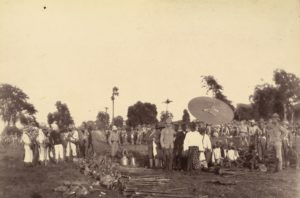Anglo-Burmese War
 (1824–26, 1852, 1885), three conflicts that collectively forced Burma (now Myanmar) into a vulnerable position from which it had to concede British hegemony in the region of the Bay of Bengal. The First Anglo-Burmese War arose from friction between Arakan in western Burma and British-held Chittagong to the north. After Burma’s defeat of the kingdom of Arakan in 1784–85, Arakanese refugees went north into British territory and from their sanctuaries in Bengal formed armed contingents and recrossed the border, attacking Burmese garrisons in Arakan. At one point, Arakanese patriots recaptured the provincial capital of Mrohaung. In retaliation, Burmese forces crossed into Bengal, withdrawing only when challenged by Bengal authorities.
(1824–26, 1852, 1885), three conflicts that collectively forced Burma (now Myanmar) into a vulnerable position from which it had to concede British hegemony in the region of the Bay of Bengal. The First Anglo-Burmese War arose from friction between Arakan in western Burma and British-held Chittagong to the north. After Burma’s defeat of the kingdom of Arakan in 1784–85, Arakanese refugees went north into British territory and from their sanctuaries in Bengal formed armed contingents and recrossed the border, attacking Burmese garrisons in Arakan. At one point, Arakanese patriots recaptured the provincial capital of Mrohaung. In retaliation, Burmese forces crossed into Bengal, withdrawing only when challenged by Bengal authorities.
In 1823 Burmese forces again crossed the frontier; and the British responded in force, with a large seaborne expedition that took Rangoon (1824) without a fight. The British hope of making the Burmese submit by holding the delta region and threatening the capital failed as Burmese resistance stiffened. In 1825 the British Indian forces advanced northward. In a skirmish south of Ava, the Burmese general Bandula was killed and his armies routed. The Treaty of Yandabo (February 1826) formally ended the First Anglo-Burmese War. The British victory had been achieved mainly because India’s superior resources had made possible a sustained campaign running through two rainy seasons. But in the fighting the British-led Indian troops had suffered more than 15,000 fatalities.
After 25 years of peace, the British Indian government sent a naval officer, Commodore Lambert, to Rangoon to investigate British merchants’ complaints of extortion. When Lambert seized a ship that belonged to the Burmese king, another war began.
 By July 1852 the British had captured the ports of Lower Burma and had begun a march on the capital. Slowly but steadily the British-Indian forces occupied the central teak forests of Burma. The new king Mindon Min (ruled 1853–78) requested the dispersal of British forces. The British were unreceptive but were hesitant to advance farther northward; with both sides at an impasse, the fighting simply ceased. The British now occupied all Lower Burma but without formal recognition of the Burmese court.
By July 1852 the British had captured the ports of Lower Burma and had begun a march on the capital. Slowly but steadily the British-Indian forces occupied the central teak forests of Burma. The new king Mindon Min (ruled 1853–78) requested the dispersal of British forces. The British were unreceptive but were hesitant to advance farther northward; with both sides at an impasse, the fighting simply ceased. The British now occupied all Lower Burma but without formal recognition of the Burmese court.
Mindon tried to readjust to the thrust of imperialism. He enacted administrative reforms and made Burma more receptive to foreign interests. To offset the British, he entertained envoys from France and sent his own emissaries there. Those moves aroused British suspicions, and Anglo-Burmese relations once again worsened. During the reign of Thibaw (1878–85), the British were willing to ignore Upper Burma and to concentrate on French moves in Laos, Vietnam, and Yunnan.
The ensuing Anglo-French tension was the result not so much of French design as of Burmese initiative. A letter to the French premier from the Hlutdaw (ministerial council) suggesting a bilateral treaty posed a direct threat to British teak monopolies in Lower Burma. Meanwhile, the Hlutdaw fined the Bombay Burmah Trading Corporation for under reporting its extractions of teak from Toungoo. That action provoked British forces to strike. The annexation of Upper Burma was announced on Jan. 1, 1886, ending the Konbaung dynasty and Burmese independence. The Third Anglo-Burmese War formally ended before it had even developed, but resistance to British rule continued for another four years.






Leave a Reply
Want to join the discussion?Feel free to contribute!